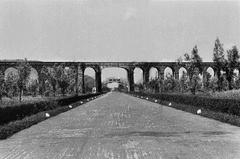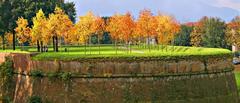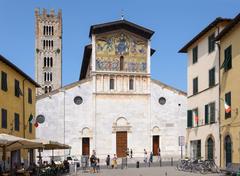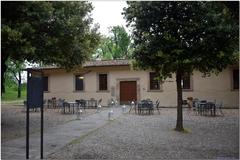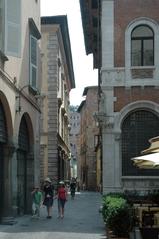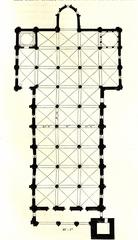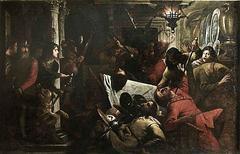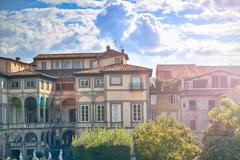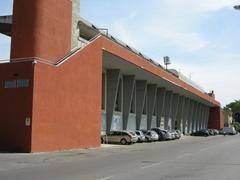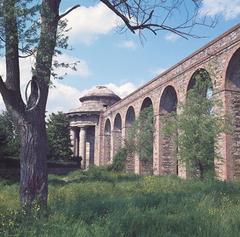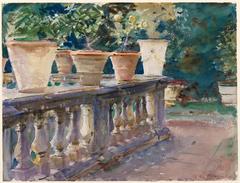Baluardo San Martino Visiting Hours, Tickets, and Travel Guide
Date: 14/06/2025
Introduction: Why Visit Baluardo San Martino in Lucca, Italy?
Baluardo San Martino, nestled within Lucca’s celebrated Renaissance walls, stands as a remarkable testament to the city’s military ingenuity and enduring independence. Built between 1592 and 1595, this bastion is one of eleven that reinforce the 4.2-kilometer circuit of Lucca’s walls—one of the best-preserved examples of Renaissance military architecture in Europe. Baluardo San Martino combines medieval defensive elements with advanced Renaissance design, offering visitors a unique window into the evolution of fortifications, panoramic Tuscan views, and access to vibrant cultural events and exhibitions.
Today, the bastion is a treasured public space, blending historical preservation with modern civic life. It hosts exhibitions in its casermetta (guardhouse), is a focal point for the Lucca Historiae Fest, and serves as a scenic promenade for locals and tourists alike. Whether you’re a history aficionado, a culture enthusiast, or seeking a tranquil stroll, Baluardo San Martino invites you to immerse yourself in Lucca’s storied past and dynamic present. For the latest updates and official visitor information, consult Turismo Lucca, Wikipedia, and Lucca.com.
Table of Contents
- Historical Overview: Origins, Evolution, and Symbolism
- Architectural and Defensive Features
- Integration with Lucca’s Urban Life
- Visiting Baluardo San Martino: Hours, Tickets, and Accessibility
- Events, Activities, and Educational Value
- Top Travel Tips & Nearby Attractions
- Frequently Asked Questions
- Conclusion and Planning Resources
- Official Sources
Historical Overview: Origins, Evolution, and Symbolism
Medieval and Renaissance Context
Lucca’s current walls, including Baluardo San Martino, were constructed in response to the increased threat posed by artillery in the 16th and 17th centuries. Earlier medieval walls were replaced under the guidance of engineers like Jacobo Seghezzi and Ginese Bresciani, with construction on Baluardo San Martino beginning in 1592 (Italy With Patri; ThinkLab360).
The Renaissance fortifications were designed to withstand cannon fire and repel sieges from powerful neighbors such as Florence and the Grand Duchy of Tuscany (Wikipedia). The bastion’s placement reinforced a weak section of the northern walls, integrating a semicircular medieval tower for added strength (ThinkLab360).
Symbolism and Historical Significance
Though the walls were never breached in battle, they became icons of Lucca’s resilience and independence. The city’s ability to maintain autonomy throughout the Middle Ages and Renaissance is embodied in its bastions, each named after local saints or figures. In 1812, the walls—Baluardo San Martino included—proved their worth during a catastrophic flood, when sealed gates protected the city’s center (Wikipedia).
Architectural and Defensive Features
Renaissance Fortification Design
Baluardo San Martino exemplifies the “trace italienne” star-fort system, with rounded flanks and thick, angular brick-and-earth ramparts designed to deflect cannonballs (visittuscany.com). Its polygonal plan, broad terreplein (upper platform), and parapets allowed for artillery placement and overlapping fields of fire.
The walls rise approximately 12 meters high and are up to 30 meters thick at the base. The core is made of compacted earth and rubble, faced with brick masonry for durability and ease of repair (nomads-travel-guide.com).
Internal Features
- Vaulted Galleries and Casemates: Subterranean passages once housed cannons, munitions, and provided protected movement for troops. Today, these brick-vaulted galleries are featured on guided tours and during special exhibitions (visittuscany.com).
- Artillery Emplacements: The terreplein supported up to 126 cannons historically, with embrasures maximizing defensive coverage (Bagni di Lucca Blog).
- Access Points: Ramps and stairways connect the bastion to the city and adjacent bastions, ensuring coordinated defense.
Integration with Lucca’s Urban Life
In the 19th century, the bastions and walls were transformed from strictly military installations into public promenades and parks under Maria Luisa de Borbón. Baluardo San Martino’s tree-lined terreplein now offers panoramic city and countryside views, shaded benches, and grassy lawns for relaxation (Itinerary Expert). The bastion’s casermetta hosts cultural events, exhibitions, and educational programs, reinforcing its role as a living monument.
Visiting Baluardo San Martino: Hours, Tickets, and Accessibility
Visiting Hours
- Walls and Bastion: Open daily, year-round. The promenade is accessible 24 hours a day.
- Casermetta Exhibitions: Typically open from 10:00 to 19:00 during festivals and special events. Check Turismo Lucca for up-to-date schedules.
Tickets
- City Walls and Bastion: Free admission.
- Exhibitions and Guided Tours: Some special exhibitions or tours may require tickets (approximately €5–€10). Purchase online or at the site (Turismo Lucca).
Accessibility and Facilities
- The promenade atop the walls is wide, mostly flat, and wheelchair accessible, with ramps at major gates such as Porta San Pietro and Porta Santa Maria (Discover Tuscany).
- Public restrooms, seating areas, and refreshment kiosks are available along the walls.
- Casermetta San Martino may have limited accessibility due to stairs; check event details in advance.
Getting There
- Location: Southern segment of Lucca’s city walls, near Porta San Pietro and close to the Cathedral of San Martino (The Crazy Tourist).
- Access: Easily reached from Lucca’s train station and historic center on foot.
Events, Activities, and Educational Value
Walking and Cycling
The 4.2-kilometer Via delle Mura Urbane connects all eleven bastions and is ideal for walking or cycling. Bicycle rentals are available near the city gates, and the route is suitable for all ages and fitness levels (The Crazy Tourist).
Festivals and Reenactments
Baluardo San Martino is central to the annual Lucca Historiae Fest each June, featuring historical reenactments, costumed processions, and interactive workshops that bring Lucca’s history to life (La Nazione).
Exhibitions and Educational Programs
Casermetta San Martino regularly hosts exhibitions related to military history, with artifact displays and multimedia presentations. Educational programs and guided tours are available for visitors and school groups (Turismo Lucca).
Top Travel Tips & Nearby Attractions
- Best Time to Visit: Spring and autumn offer pleasant weather and fewer crowds. The Lucca Historiae Fest in June is especially lively.
- Nearby Attractions: Cathedral of San Martino, Piazza Napoleone, and Via Fillungo for shopping and dining.
- Photography: The bastion offers superb panoramic views—sunrise and sunset are ideal times.
- Facilities: During festivals, additional amenities (food stalls, information booths) are available near the bastion.
Frequently Asked Questions (FAQ)
What are Baluardo San Martino’s visiting hours?
The walls and bastion promenade are open 24/7; exhibitions usually run 10:00–19:00 during special events.
Is there an entry fee?
No, access to the walls and bastion is free. Special exhibitions or guided tours may require a ticket.
Is Baluardo San Martino wheelchair accessible?
Yes, the promenade is accessible. Internal galleries may have some limitations; check ahead for details.
Can I rent a bike nearby?
Yes, several rental shops near the city gates offer bicycles suitable for wall exploration.
When is the best time to visit?
Spring and autumn for mild weather; June for the Lucca Historiae Fest.
Are pets allowed?
Yes, but they should be leashed and owners must clean up after them.
Conclusion and Planning Resources
Baluardo San Martino is more than a historical monument—it’s a living part of Lucca’s community, combining Renaissance military architecture, cultural events, and scenic urban parkland. With free access, educational programs, and its integration into Lucca’s broader heritage, it’s an essential stop for anyone visiting Tuscany.
Plan your visit using the official Lucca tourism website, download the Audiala app for audio guides and the latest event updates, and follow our social media for ongoing travel tips and inspiration.
Official Sources
- Walls of Lucca, Wikipedia
- Lucca Walls and Ramparts, Italy With Patri
- Baluardo San Martino Mura di Lucca, ThinkLab360
- A Baluardo Bastion on Lucca’s Wall, Bagni di Lucca Blog
- Lucca’s Historic Walls, Lucca WhatsOn
- I Baluardi delle Mura di Lucca, Visit Tuscany
- Lucca City Walls and Bastions, Nomads Travel Guide
- The Walls of the City of Lucca, Lucca.com
- Porte delle Mura di Lucca, Lucca.com
- Lucca Tourism Official Site, Turismo Lucca
- 15 Best Things to Do in Lucca, The Crazy Tourist
- Lucca Historiae Fest, La Nazione
- Discover Tuscany - Lucca, Discover Tuscany
- Itinerary Expert - Mura di Lucca, Itinerary Expert
